
A desert is a landscape or region that receives almost no precipitation. Deserts are defined as areas with an average annual precipitation of less than 250 millimetres (10 in) per year, or as areas where more water is lost by evapotranspiration than falls as precipitation.
The following are five beautiful deserts in China:
1. Badain Jaran Desert in Inner Mongolia
Covering an area of 49,000 square kilometers, Badain Jaran Desert is the third largest desert in China and the forth largest in the world. It located in Araxan League of north China's Inner Mongolia autonomous region.With an area of 47,000 square kilometers, the desert has the tallest sand hill at over 500 meters, so it is also called the "Qomolangma of Deserts".There are numerous moon-shaped and pyramid-shaped sand dunes and all kinds of sand hills with an average height of over 200 meters. Its queer peaks, sound-sand, lakes and springs are called the "four features" of Badain Jaran Desert.
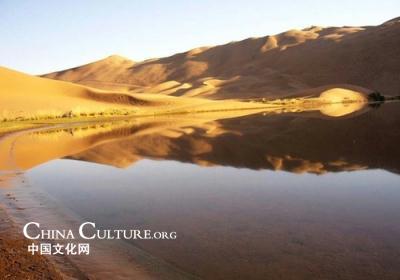
2. Taklimakan Desert in Xinjiang
The Taklamakan Desert, also known as Taklimakan, is a desert in Central Asia, in the Xinjiang Uyghur autonomous region of China. As one of the largest sand deserts in the world, the Taklimakan Desert covers an area of 330,000 square kilometers.It is bounded by the Kunlun Mountains to the south, and the Pamir Mountains and Tian Shan (ancient Mount Imeon) to the west and north. It is crossed at its northern and at its southern edge by two branches of the Silk Road as travelers sought to avoid the arid wasteland. "Taklimakan" has the meaning that you can never get out of the place once you step in it. The sand hills in the desert are 300 meters high. When wind blows the sand up, the hills can reach a height of 900 meters.
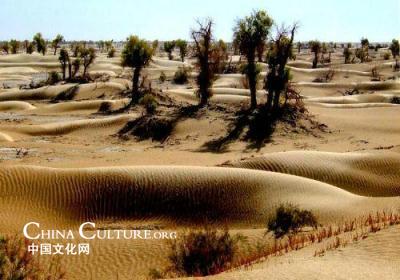
3. Gurbantunggut Desert in Xinjiang
The Gurbantunggut Desert, located in the center of Junggar Basin, to the east of the Manas River and south of the Ulungur River. With an area of 48,800 square meters, the desert is the second largest desert in China. Its climate is temperate. Its eco-environment is very fragile, and the impact of human activities on the eco-environment, including the building of a trans-desert highway, has been increasingly significant.The sand hills in the desert are 300 to 600 meters above sea level.
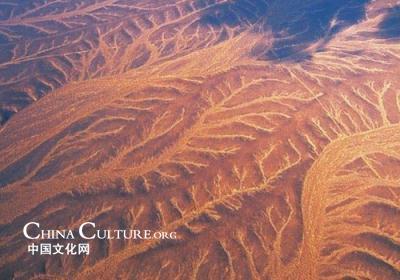
4. Singing Sand Dunes & Crescent Moon Spring in Gansu
Singing sand, is sand that produces sounds of either high or low frequency under pressure. The sound emission is usually triggered by wind passing over dunes or by walking on the sand. The sound is generated by shear stress.
The Crescent Moon Spring locates at 5km south of Dunhuang city in Gansu. Since time immemorial, the scenic spot is famous across the whole world for its “Coexistence of mountain and spring, sand and water”. It is appraised as “Unique Scenery in the north of Great Wall”, and listed as National Key Tourist Attractions of the People's Republic of China in 1994. About over 300 meters long and 50 meters wide, the Crescent Moon Spring is surrounded by Singing sand Dunes. The poplars stand elegantly beside the spring and fishes swim happily and leisurely. The spring water tastes fresh and sweet and water in the color of light blue.
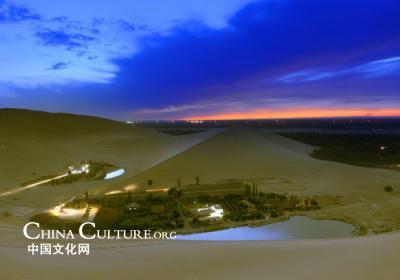
5. Shapotou in Ningxia
Shapotou Desert is located on the southern edge of the Tengger Desert. It is the site of the world-renowned Shapotou Desert Experimental Research Station. There is also singing sand in Shapotou. Thousands of domestic tourists descend upon Shapotou each year to enjoy the natural scenery and partake in various activities on and around the 100-metre high dunes.It has a width of 2,000 meters and a height of 100 meters with an inclination of 60 degrees. When standing at the foot of the sand hills, you can see what looks like a waterfall, but is actually sand.
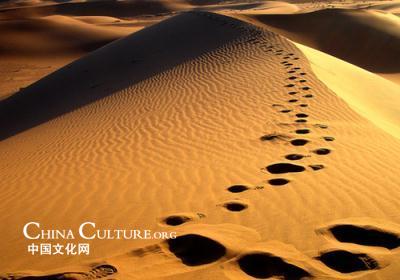

2013 Chinese New Year |

Hidden dragons, crouching tigers |

Soap beans, silver ears and peach gum |

Special:Winter Solstice |

'Potato festival' kicks off in Shandong |

Mario themed restaurant opens in Tianjin |

HK carries out avian influenza tests on imported chicken |

2013 China Tea Conference kicks off in Zhejiang |